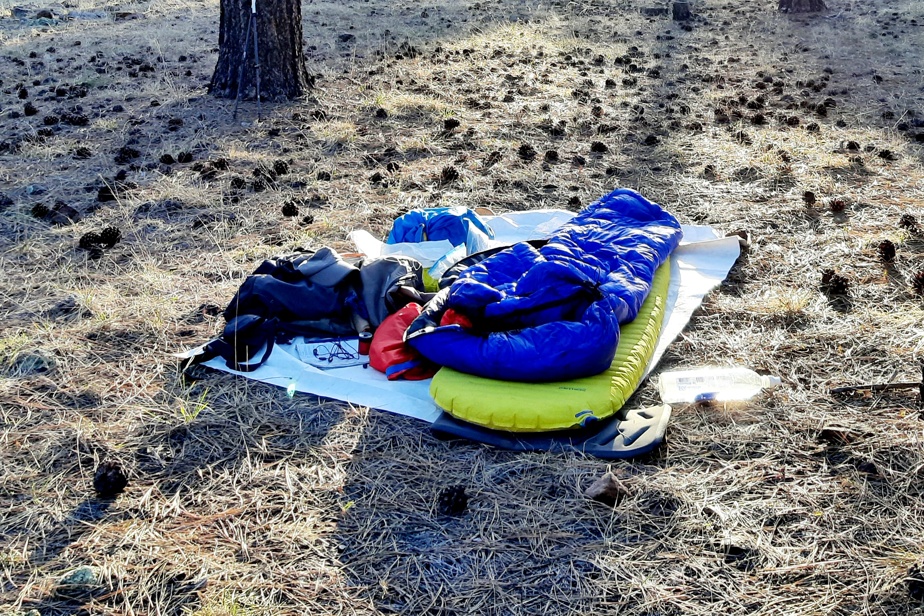Admire the stars for a moment then feel your eyelids close. Waking up in the early morning with a ray of sunshine tickling our noses. Sleeping under the stars can be a most pleasant experience when the conditions are right.
“You choose a month when there are fewer mosquitoes,” notes Hugo Drouin. I would also have my plan B nearby, either a tent or a canvas that I would put in my backpack. »
Hugo Drouin is an expert on the subject. In 2022, he independently completed the 1,300 kilometers of the Arizona Trail. Out of about fifty nights, he spent about forty sleeping under the stars, what they call “cowboy camping” there.
“All I did was lay my sleeping mat down on the desert or mountain floor. I saved a lot of time doing this because I didn’t have to set up or take down a tent. It’s also a great way to connect even more with nature. Feeling the breeze, the freshness on our face while we sleep, it’s super pleasant. »
Gazing at the stars from the comfort of your sleeping bag can, however, have certain disadvantages.
“The best experience I had was in the mountains of Morocco,” says Géraldine Trouillard, an experienced hiker. It’s a beautiful starry sky, there was no light pollution. The only downside was that it was so beautiful that I almost didn’t sleep because I couldn’t stop looking at the sky. »
She had another difficult night in Corsica because she felt like she was surrounded by animals. “I saw dark masses all around. When we woke up, our “camp” was surrounded by holes dug by wild pigs. »
In Arizona, we are more concerned about snakes, scorpions and coyotes. Rumors abound about reptiles finding their way into sleeping bags because they seek warmth.

PHOTO PROVIDED BY HUGO DROUIN
Hugo Drouin brings a small emergency tarpaulin when the weather is not suitable for sleeping under the stars.
“In 40 nights, I had no unpleasant encounter with wildlife,” says Hugo Drouin. The first thing I did every morning was shake out my boots to make sure there weren’t any bugs in them. A kind of cowboy reflex. »
He also never lost sight of his sleeping bag when he had to get up at night. The only annoyance was that a small creature, probably a hare, chewed off a piece of walking stick. “From that day on, I got into the habit of leaning them on a bush or hanging them high up on a small branch. »
Hugo Drouin manages the food as he would if he were in a tent. “I have the same preventive measures. If I had to hang my food for the bears, I would. »
When it comes to wild animals, Joëlle Dupont believes that it is more reassuring to see what is happening around you. “When there are noises, I can see where it’s coming from,” she exclaims.
Choose your site wisely

PHOTO PROVIDED BY MICHEL CAREAU
A quiet little corner, far from the trail and the peaks
The choice of a site is obviously important. “I want something grassy or rocky, otherwise it’s too dirty, you end up having lots of soil on everything, on your stock and in your sleeping bag,” comments Joëlle Dupont.
You should also avoid the summits: it is a fragile environment and you risk damaging delicate vegetation either by sleeping on it or by moving to attend to natural needs.
Michel Careau recommends standing away from the trail and checking what is above you. “We definitely don’t want a branch to fall on us,” he notes.
Janusz Augustyniak did not have this problem when he had to sleep under the stars during a long climb in Peru, on a narrow ledge at 5050 meters above sea level.
“It was windy at 80 km/h and it was quite cold at altitude, but the goretex bivouac bag that I had protected me very well from the bad weather. We were just getting tossed around a little in the sleeping bags. I had one of my best nights of sleep there. »
The bivouac bag can actually make sleeping under the stars very comfortable. Some are very simple, others are more elaborate, with mosquito nets and arches to allow better ventilation. But it’s starting to look like a minimalist tent. To sleep under the stars, a good sleeping bag can do the trick, especially in the fall. “The biting insects are no longer there, the nights are cooler,” notes Michel Careau.
The weather obviously matters. We know that in Quebec, it rains a little more than in the Arizona desert.
Video suggestion
Dreamer
Injured, a mountain biker dreams of his passion.
Number of the week
4000
Kayaks have been around for at least 4,000 years.
